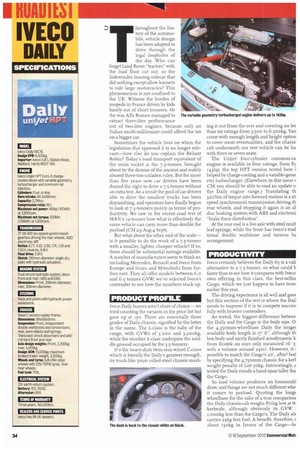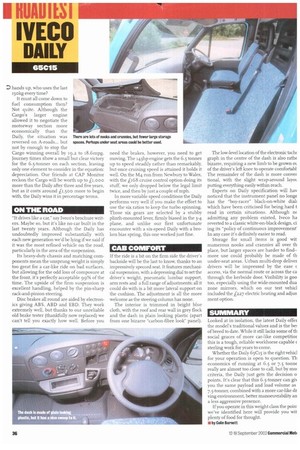hroughout the history of the automobile, vehicle design has been
Page 34

Page 36

If you've noticed an error in this article please click here to report it so we can fix it.
adapted to drive through the legal loopholes of the day. Who can
forget Land Rover -tractors" with the load floor cut out, or the Sidewinder leaning sidecar that did nothing except allow learners to ride large motorcycles? This phenomenon is not confined to the UK. Witness the hordes of mopeds in France driven by kids barely out of short trousers. Or the way Alfa Romeo managed to extract three-litre performance out of two-litre engines, because only an Italian multi-millionaire could afford the tax on a bigger car.
Sometimes the vehicle lives on when the legislation that spawned it is no longer relevant—how else do you explain the Reliant Robin? Today's road transport equivalent of the resin rocket is the 7.5-tonner, brought about by the demise of the ancient and widely abused three-ton-unladen rules. But for more than five years new car drivers have been denied the right to drive a 7.5-tonner without an extra test. As a result the pool of car drivers able to drive the smallest trucks has been diminishing, and operators have finally begun to look at 7.5-tonners purely in terms of productivity. We saw in the recent road test of MAN's 12.-tonner how what is effectively the same vehicle can carry more than double the payload (CM 29 Aug-4 Sept).
But what about the other end of the scale— is it possible to do the work of a 7.5-tonner with a smaller, lighter, cheaper vehicle? If so, there should be substantial savings available. A number of manufacturers seem to think so, including Mercedes, Renault and Iveco from Europe and Isuzu and Mitsubishi from further east. They all offer models between 6.o and 6.5 tonnes GVW; we've selected Iveco's contender to see how the numbers stack up.
PRODUCT pnerox
Iveco Daily buyers aren't short of choice—we tried counting the variants in the price list but gave up at 15o. There are essentially three grades of Daily chassis, signified by the letter in the name. The L-class is the baby of the range, with GVWs of 3,000 and 3.200kg, while the sturdier S-class underpins the middle ground occupied by the 3.5-tonners.
It's the heavy-duty twin-rear-wheel C-class which is literally the Daily's greatest strength, its truck-like 5mm rolled-steel chassis mark trig it out from the rest and covering no les than six ratings from 3,500 to 6,500kg. Van come with enough length and height option to cover most eventualities, and the chassi: cab underneath our test vehicle can be ha with three or seven seats.
The Unijet four-cylinder common-ra engine is available in four ratings, from 85, 143hp; the top HPT version tested here i helped by charge-cooling and a variable-geon etry turbocharger. (Elsewhere in this issue c CM, you should be able to read an update o the Daily engine range.) Translating th 32oNm of torque into forward motion is a si: speed synchromesh transmission driving th rear wheels, and stopping it again is an al disc braking system with ABS and electroni "brake force distribution".
At the rear end is a live axle with steel mult leaf springs, while the front has Iveco's trad fional double wishbone and torsion ba arrangement.
PRODUCTIVITY
Iveco certainly believes the Daily 65 is a vali alternative to a 7.5-tonner, so what could b fairer than to see how it compares with Iveco' own offering in this class, the best-sellin Cargo, which we just happen to have teste earlier this year.
The driving experience is all well and goo( but this section of the test is where the Dail needs to impress if it is to compete succes: fully with heavier contenders.
As tested, the biggest difference betwee the Daily and the Cargo is the body size. 0 the 4,350mm-wheelbase Daily the longe: available body length is 17' 6", although th box body and nicely finished aerodynamic k from Ecotek on ours only measured 16' 3' with a volume around 23m3. However, it possible to match the Cargo's 20% 28M3 bod by specifying the 4,750mm chassis, for a kerl weight penalty of just 30kg. Interestingly, a tested the Daily stands a hand-span taller tha the Cargo.
So load volume produces an honourabl draw, and things are not much different whe it comes to payload. Quoting the longt wheelbase for the sake of a true comparisoi the Daily chassis-cab weighs 8711cg less at tin kerbside, although obviously its GVW 1, 000kg less than the Cargo's, The Daily als carries 25kg less fuel. A benefit, therefore, ( about r5okg in favour of the Cargo—bi
P hands up, who uses the last 150kg every time?
It must all come down to fuel consumption then? Not quite. Although the Cargo's larger engine allowed it to negotiate the motorway section more economically than the Daily, the situation was reversed on A-roads... but not by enough to stop the Cargo winning overall by 19.2 to 18.6mpg. Journey times show a small but clear victory for the 6.5-tonner on each section, leaving only one element to consider in the equation: depreciation. Our friends at CAP Monitor reckon the Cargo will be worth up to £1,000 more than the Daily after three and five years, but as it costs around 11,500 more to begin with, the Daily wins it in percentage terms.
ON THE ROAD
"It drives like a car," say Iveco's brochure writers. Maybe so, but it's like no car built in the last twenty years. Although the Daily has undoubtedly improved substantially with each new generation we'd be lying if we said if it was the most refined vehicle on the road, particularly in the area of the suspension.
Its heavy-duty chassis and matching components mean the unsprung weight is simply too great for a car-like ride on bad surfaces, but allowing for the odd loss of composure at the front, it's perfectly acceptable 99% of the time. The upside of the firm suspension is excellent handling, helped by the pin-sharp rack-and-pinion steering.
Disc brakes all round are aided by electronics giving ABS, ABD and EB D. They work extremely well, but thanks to our unreliable old brake tester (thankfully now replaced) we can't tell you exactly how well. Before you need the brakes, however, you need to get moving. The 143hp engine gets the 6.5 tonnes up to speed steadily rather than remarkably, but once cruising speed is attained it holds it well. On the M4 run from Newbury to Wales, with the £168 cruise control option doing its stuff, we only dropped below the legal limit twice, and then by just a couple of mph.
In more variable speed conditions the Daily performs very well if you make the effort to use the six ratios to keep the turbo spinning. Those six gears are selected by a stubby plinth-mounted lever, firmly biased in the 3-4 plane, and unlike our first unfortunate encounter with a six-speed Daily with a broken bias spring, this one worked just fine.
CAB COMFORT
If the ride is a bit on the firm side the driver's backside will be the last to know, thanks to an impressively specced seat. it features mechanical suspension, with a depressing dial to set the driver's weight, pneumatic lumbar support, arm rests and a full range of adjustments; all it could do with is a bit more lateral support on the cushion. The adjustment is all the more welcome as the steering column has none.
The interior is trimmed in bright blue cloth, with the roof and rear wall in grey flock and the dash in plain looking plastic (apart from one bizarre "carbon-fibre look" panel). The low-level location of the electronic tacks graph in the centre of the dash is also rathe bizarre, requiring a new limb to be grown ot of the driver's left knee to operate comfortabl The remainder of the dash is more conver tional, with the slight wrap-around layot putting everything easily within reach.
Experts on Daily specification will hay noticed that the instrument panel no longe has the "boy-racer" black-on-white dial: which have been criticised for being hard t read in certain situations. Although tic admitting any problem existed, lveco ha reverted to a dassic white-on-black design. ci ing its "policy of continuous improvement' In any case it's definitely easier to read.
Storage for small items is good wit numerous nooks and crannies all over th place, but larger spaces are harder to find— more use could probably be made of th under-seat areas. Urban multi-drop deliver drivers will be impressed by the ease c access, via the normal route or across the ca through the kerbside door. Visibility is goo too, especially using the wide-mounted dua zone mirrors, which on our test vehicl included the £227 electric heating and adjus ment option.
SUMMARY
Looked at in isolation, the latest Daily offet the model's traditional values and is the be of breed to date. While it still lacks some of th social graces of more car-like competitiot this is a tough, reliable workhorse capable ( sterling work for years to come.
Whether the Daily 65C15 is the right vehicl for your operation is open to question. Th economics of running at 6.5 or 7.5 tonne really are almost too close to call, but by mo: criteria, the Daily just gets the decision o points. It's clear that this 6.5-tonner can giN you the same payload and load volume as 7.5-tonner, combined with a more car-like dr ving environment, better manoeuvrability an a less aggressive presence.
If you operate in this weight class the poin we've identified here will provide you wit plenty of food for thought.
• by Colin Barnett




























































































































































